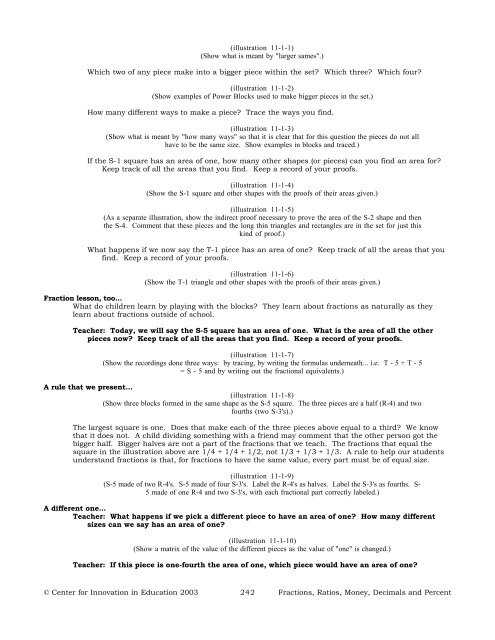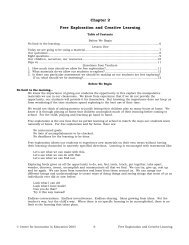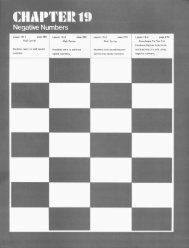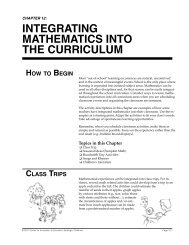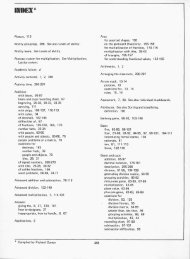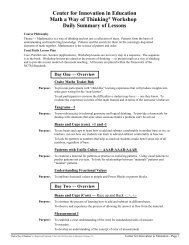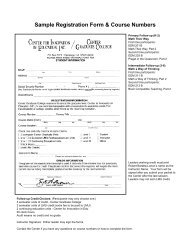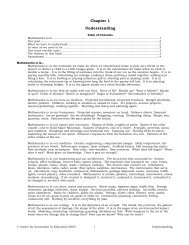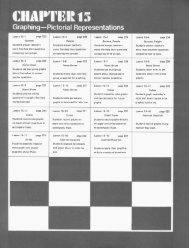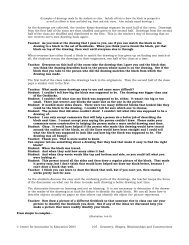Chapter 11 Fractions, Ratios, Money, Decimals and Percent
Chapter 11 Fractions, Ratios, Money, Decimals and Percent
Chapter 11 Fractions, Ratios, Money, Decimals and Percent
Create successful ePaper yourself
Turn your PDF publications into a flip-book with our unique Google optimized e-Paper software.
(illustration <strong>11</strong>-1-1)(Show what is meant by "larger sames".)Which two of any piece make into a bigger piece within the set? Which three? Which four?(illustration <strong>11</strong>-1-2)(Show examples of Power Blocks used to make bigger pieces in the set.)How many different ways to make a piece? Trace the ways you find.(illustration <strong>11</strong>-1-3)(Show what is meant by "how many ways" so that it is clear that for this question the pieces do not allhave to be the same size. Show examples in blocks <strong>and</strong> traced.)If the S-1 square has an area of one, how many other shapes (or pieces) can you find an area for?Keep track of all the areas that you find. Keep a record of your proofs.(illustration <strong>11</strong>-1-4)(Show the S-1 square <strong>and</strong> other shapes with the proofs of their areas given.)(illustration <strong>11</strong>-1-5)(As a separate illustration, show the indirect proof necessary to prove the area of the S-2 shape <strong>and</strong> thenthe S-4. Comment that these pieces <strong>and</strong> the long thin triangles <strong>and</strong> rectangles are in the set for just thiskind of proof.)What happens if we now say the T-1 piece has an area of one? Keep track of all the areas that youfind. Keep a record of your proofs.(illustration <strong>11</strong>-1-6)(Show the T-1 triangle <strong>and</strong> other shapes with the proofs of their areas given.)Fraction lesson, too...What do children learn by playing with the blocks? They learn about fractions as naturally as theylearn about fractions outside of school.Teacher: Today, we will say the S-5 square has an area of one. What is the area of all the otherpieces now? Keep track of all the areas that you find. Keep a record of your proofs.(illustration <strong>11</strong>-1-7)(Show the recordings done three ways: by tracing, by writing the formulas underneath... i.e. T - 5 + T - 5= S - 5 <strong>and</strong> by writing out the fractional equivalents.)A rule that we present...(illustration <strong>11</strong>-1-8)(Show three blocks formed in the same shape as the S-5 square. The three pieces are a half (R-4) <strong>and</strong> twofourths (two S-3's).)The largest square is one. Does that make each of the three pieces above equal to a third? We knowthat it does not. A child dividing something with a friend may comment that the other person got thebigger half. Bigger halves are not a part of the fractions that we teach. The fractions that equal thesquare in the illustration above are 1/4 + 1/4 + 1/2, not 1/3 + 1/3 + 1/3. A rule to help our studentsunderst<strong>and</strong> fractions is that, for fractions to have the same value, every part must be of equal size.(illustration <strong>11</strong>-1-9)(S-5 made of two R-4's. S-5 made of four S-3's. Label the R-4's as halves. Label the S-3's as fourths. S-5 made of one R-4 <strong>and</strong> two S-3's, with each fractional part correctly labeled.)A different one...Teacher: What happens if we pick a different piece to have an area of one? How many differentsizes can we say has an area of one?(illustration <strong>11</strong>-1-10)(Show a matrix of the value of the different pieces as the value of "one" is changed.)Teacher: If this piece is one-fourth the area of one, which piece would have an area of one?© Center for Innovation in Education 2003 242 <strong>Fractions</strong>, <strong>Ratios</strong>, <strong>Money</strong>, <strong>Decimals</strong> <strong>and</strong> <strong>Percent</strong>


